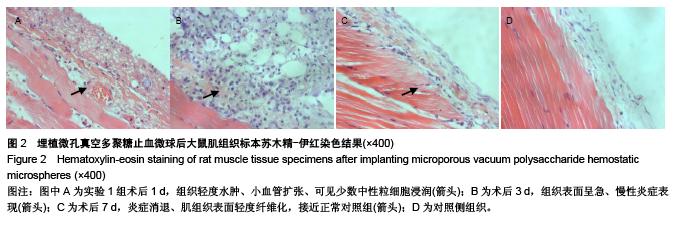| [1] Sauai A, Moore FA,Moore EE, et al. Epidemiology of trauma deaths: A reassessment. J Trauma. 1995;38(2):185-193.
[2] Champion HR, Bellamy RF, Roberts CP, et al. A profile of combat injury. J Trauma. 2003;54(5):S13-S19.
[3] Stewart RM, Myers JG, Dent DL, et al. Seven humdred fifty-three consecutive deaths in a level 1 trauma center: The argument for injury prevention. J Trauma. 2003;54(1):66-71.
[4] Kauvar DS, Lefering R, Wade CE. Impact of hemorrhage on trauma outcome: an overview of epidemiology, clinical presentations, and therapeutic considerations. J Trauma. 2006;60(6 suppl):S3-S11.
[5] 李钒,田丰,刘长军,等.急救止血材料的研究进展[J].材料导报, 2013,27(3):70-73.
[6] 史跃,杜宝堂,何远清,等.多微孔多聚糖止血粉应用于软组织创伤出血[J].中国组织工程研究,2014,18(3):406-411.
[7] 李东红,高华,李鹏熙,等.几种止血材料对兔实质脏器创伤止血性能的比较[J].创伤外科杂志,2012,14(5):435-435.
[8] Emilia M, Luca S, Francesca B, et al. Topical hemostatic agents in surgical practice. Transfus Apher Sci. 2011; 45(3): 305-311.
[9] Kim IY, Eichel L, Edwards R, et al. Effects of commonly used hemostatic agents ofn the porcine collecting system. J Endourol. 2007;21(6):652-654.
[10] 张少锋,洪加源.医用生物可吸收止血材料的研究现状与临床应用[J].中国组织工程研究,2012,16(21):3941-3944.
[11] 熊绪琼,梅昕,马凤森.多糖类可吸收止血材料的研究进展[J].中华创伤杂志,2015,31(6):571-574.
[12] 武岳,王冰,姚天明.新型创伤急救止血材料的研究进展[J].中国临床实用医学,2014,5(4):78-80.
[13] 中华人民共和国科学技术部.关于善待实验动物的指导性意见. 2006-09-30.
[14] Granville-Chapman J, Jacobs N, Midwinter MJ. Per-hospital haemostatic dressings: a systematic review. Injury. 2011; 42(5): 477-459.
[15] Gruen RL, Brohi K, Schreiber M, et al. Haemorrhage control in severely injured patients. Lancet. 2012;380(9847): 1099-1108.
[16] Seyedenejad H, Imani N, Jamieson T, et al. Topical haemostatic agents. British J Surg. 2008;95(10):1197-1225.
[17] Schwartz M, Madariaga J, Hirose R, et al. Comparison of a new fibrin sealant with standard topical hemostatic agents. Arch Surg. 2004;139(11):1148-1154.
[18] Spotnitz WD. Fibrin sealabt: past, present, and future: a brief review. World J Serg. 2010,34(4):632-634.
[19] Jackson MR. Fibrin sealants in surgical practice: an overview. Am J Surg. 2001;182(2 suppl):1S-7S.
[20] Palm MD, Altman JS. Topical hemostatic agents: a review. Dermatol Surg. 2008;34(4):431-445.
[21] Achneck HE, Sileshi B, Jamiolkowski RM, et al. A comprehensive review of topical hemostatic agents efficacy and recommendations for use. Ann Surg. 2010;251(2): 217-228.
[22] 余雪松,黄赤兵,张艮甫.局部止血材料临床应用现状[J].创伤外科杂志,2008,10(6):565-567.
[23] Alam HB, Burris D, DaCorta JA, et al. Hemorrhage Control in the Battlefield: Role of New Hemostatic Agents. Mil Med. 2005;170(1):63-69.
[24] 刘亚平,侯春林,顾其胜,等.可生物降解止血粉的制备及其止血性能[J].中国重建外科杂志,2007,21(8):829-832.
[25] 杜宝堂.利用植物淀粉经交叉乳化制备术中止血材料的方法:中国,201110073208.2[P].2013-07-17.
[26] 史跃,沈烈,杜宝堂,等.微孔多聚糖止血球组织吸收实验研究[J].医疗卫生装备,2014,35(8):15-18.
[27] Tschan CA, Nie M, Schwandt E, et al. Safety and efficacy of microporous polysaccharide hemospheres in neurosurgery. Neurosurgery. 2011;69(1 suppl operative):49-62.
[28] 牛雯,刘毅,刘曼玲.一种可吸收止血材料的生物降解研究[J].中国新药杂志,2012,19(4):336-339.
[29] 王勇,陆伟.体内可吸收止血材料研究及临床应用[J].生物医学工程杂志,2009,2(4):922-925.
[30] 张华.甲状腺手术应用泰绫150例探讨[J].中国医药导报, 2009, 6(19):207-209.
[31] Azevedo C, Marques M, Bombana A. Cytotoxic effects of cyanoacrylates used as retrograde filling materials: An in vitroanalysis. Pesqui Odontol Bras. 2003;17(2):113-118.
[32] Yi KI, Louis E, Robert E, et al. Effects of commonly used hemostatic agents on the porcine collecting system. J Endourol. 2007;21(6):652-654.
[33] Johan B, Pentti T. Blood protein adsorption onto chitosan. Biomaterials. 2002;23(12):2561-2568.
[34] Ishihara M. Photocrosslinkable chitosan as a dressing for wound occlusion and accelerator in healing process. Bomaterials. 2002;23(3):833-840.
[35] Tsuyoshi S. Locak hemostatic effects of mirocrystalling partially deacetylated chitin hydrochloride. J Biomed Mater Res. 2000;49(2):225-232. |



.jpg)
